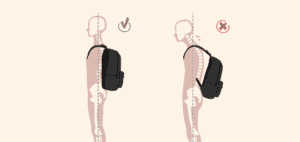

Imagine a scenario wherein you are walking to school or work, backpack loaded with everything but the kitchen sink, and feeling like a camel carrying its weekly water supply.
Your neck starts to ache, your shoulders are screaming, and you suddenly understand why neck massages exist.
We do not often think about how much damage a heavy backpack can do, but lugging around all that weight can mess with your neck alignment in some seriously unpleasant ways.
In this article, we shall explore the anatomy of neck alignment, the science of muscle strain caused by heavy loads, and real-life stories of people who have learned this the hard way.
From understanding what happens when you cannot turn your head to recognizing signs your neck is out of alignment, we will cover it all.
In This Article:
- The Anatomy of Neck Alignment and How It’s Supposed to Work
- How Heavy Backpacks Disrupt Your Neck’s Balance
- The Role of Muscle Strain in Neck Pain
- Real-Life Example: The High Schooler Carrying a Mini Library
- Why the Right and Left Sides of Your Neck Feel Uneven
- The Chain Reaction: How Shoulder Pain Extends to Your Neck
- Recognizing the Signs Your Neck is Out of Alignment
- Conclusion: Understanding the Toll of Heavy Backpacks
The Anatomy of Neck Alignment and How it is Supposed to Work
Before we dive into why heavy backpacks are the arch-nemesis of good posture, let’s talk about neck anatomy.
Your neck, or cervical spine, consists of seven vertebrae that act like a well-oiled machine, balancing your head (which, by the way, weighs about as much as a bowling ball).
Ideally, your neck should be in a neutral position, aligning your head directly above your shoulders.
This keeps stress on the neck muscles and vertebrae to a minimum.
However, when you sling a heavy backpack onto your shoulders, your neck has to compensate to keep your body upright.
According to research in the Journal of Physical Therapy Science, even a slight forward tilt of the head can double the strain on your neck muscles, leading to discomfort and long-term misalignment.
How Heavy Backpacks Disrupt Your Neck’s Balance?
Let us walk you through how your neck takes unnecessary stress when you are adding weight to your upper back and shoulders:
Load-Bearing Gone Wrong:
Your body was not designed to haul around a mini-fridge disguised as a backpack. When you sling on a heavy load, it shifts your center of gravity backward. To avoid falling over like a cartoon character, you instinctively lean forward.
Your Neck Pays the Price:
This lean causes your head to protrude in front of your shoulders, a classic case of forward head posture. According to The Spine Journal (2022), this position increases compressive forces on the cervical vertebrae and soft tissues by up to 60%.
Muscles Cry for Help:
The deeper cervical flexors and stabilizers are now working overtime to keep your head from dangling like a broken puppet. Fatigue sets in, leading to pain, stiffness, and tension headaches.
Chronic Adaptation = Bad News:
The body starts adapting to this “temporary” posture. Over time, forward head posture becomes the new normal—even when the backpack is off. Researchers in The Journal of Physical Therapy Science found a direct correlation between prolonged backpack use and persistent cervical spine misalignment in adolescents.
Strain Triggers a Domino Effect:
Tight upper traps, overstretched lower cervical extensors, and rounded shoulders (also known as mom’s shoulders) come as a package deal. Long-term, this posture can lead to thoracic kyphosis, restricted breathing, and decreased visual field.
Backpack Weight Limits Matter:
As per guidelines from the American Academy of Pediatrics, your backpack should not exceed 10–15% of your body weight. Exceed that, and your neck might just start its own protest march.
So yes, heavy backpacks are neck saboteurs in disguise—and your cervical spine is not amused.
The Role of Muscle Strain in Neck Pain
Ever experienced neck pain after lifting something heavy? You are among many more.
The muscles in your neck, including the trapezius and levator scapulae, work overtime when you carry heavy loads.
This muscle strain leads to inflammation, stiffness, and a burning sensation, especially if the load is not evenly distributed across both shoulders.
A 2018 study from Clinical Biomechanics found that carrying asymmetrical loads (like a backpack slung over one shoulder) exacerbates muscle imbalance, making you more prone to injury.
When you add weight that exceeds 10-15% of your body weight, your neck’s ability to maintain alignment decreases, making it susceptible to strain and even microtears.
The High Schooler Carrying a Mini Library
Meet Emily, a high school junior who loves her books so much she practically carries a mini library in her backpack.
With textbooks, binders, and snacks, Emily’s bag easily weighs over 20 pounds.
Within a semester, she noticed persistent neck pain and struggled to turn her head to the right.
After a visit to her physical therapist, she discovered she had pulled neck muscles and could not rotate her head without discomfort.
Emily’s story is not unique. Students and professionals alike are dealing with neck pain because of the heavy loads they carry.
The Journal of Adolescent Health states that up to 80% of school-aged children report shoulder and neck pain on the right side, often linked to carrying heavy backpacks.
Why the Right and Left Sides of Your Neck Feel Uneven?
If you’ve ever noticed one shoulder sitting higher than the other or felt uneven tension in your neck, you’re not alone. Uneven shoulders can stem from various daily habits and underlying conditions. Here are some common causes:
One-Sided Bag Carrying – Regularly carrying a heavy bag on one side forces the muscles on that side to work harder, creating imbalances. Over time, this can pull one shoulder downward, leading to strain and discomfort. As per Campbell Clinic, consistently carrying heavy bags can contribute to shoulder and back pain.
Poor Posture Habits – Slouching or leaning to one side while sitting or standing puts uneven stress on your muscles. As per Healthline, prolonged poor posture can lead to long-term shoulder imbalances.
Sedentary Lifestyle – Sitting for long hours without proper movement weakens some muscles while overworking others, leading to asymmetry.
Injury or Trauma – Previous injuries such as fractures, dislocations, or muscle tears, whiplash injury may cause compensatory movements, which result in uneven shoulders. According to Medical News Today, past injuries often lead to postural imbalances.
Scoliosis – A spinal curvature condition that causes one shoulder to sit higher than the other. As per Medical News Today, scoliosis is a common cause of uneven shoulders.
Nerve Impingement – Compressed nerves in the neck or upper back can lead to muscle weakness, making one shoulder appear lower. Healthline notes that nerve issues can significantly impact muscle function.
Sleeping Position – Consistently sleeping on one side can tighten muscles on that side, contributing to imbalance. You would therefore need to learn how to adjust your sleep position to ease the neck and shoulder discomfort.
Stress and Anxiety – Emotional stress often leads to muscle tension, particularly in the neck and shoulders, creating an uneven feeling. According to Centeno-Schultz Clinic, stress-related tension can cause persistent discomfort.
Improper Exercise Form – Performing exercises with incorrect form can strengthen one side more than the other, creating muscle imbalances.
Structural Issues – Flat feet or a slight difference in leg length can alter posture, leading to uneven shoulder positioning. Healthline reports that lower body misalignments can affect upper body posture.
Addressing these factors with proper posture, balanced exercise routines, and stress management can help restore alignment and reduce discomfort. If the issue persists, seeking professional guidance may be beneficial.
The Chain Reaction: How Shoulder Pain Extends to Your Neck?
Your body is like a chain; when one link is off, the rest are affected.
Shoulder pain caused by heavy backpacks often extends to the neck.
The upper trapezius and levator scapulae muscles, which connect your shoulders to your neck, bear the brunt of the weight.
Over time, this can lead to neck pain and even conditions like thoracic outlet syndrome, where nerves and blood vessels are compressed between the collarbone and first rib.
If you have ever thought, “I have shoulder and neck pain on the right side, and I don’t know why,” it could be due to your backpack habits.
The American Journal of Sports Medicine suggests that uneven shoulder loads are a major contributor to chronic neck and shoulder pain.
Recognizing the Signs Your Neck is Out of Alignment
How do you know if your neck is crying for help?
Common signs your neck is out of alignment include headaches, difficulty turning your head, and that all-too-familiar forward head posture.
You may even experience numbness or tingling in your hands if nerves are compressed.
If you feel like you have pulled a neck muscle and cannot turn your head, it is a clear indicator that your neck alignment is compromised.
Experts from Orthopedic Clinics of North America emphasize that prolonged misalignment can lead to degenerative disc disease or cervical spondylosis.
Ignoring these signs can result in long-term damage, so it is crucial to recognize and address the symptoms early.
Understanding the Toll of Heavy Backpacks
Carrying a heavy backpack might seem like a minor inconvenience, but it can wreak havoc on your neck alignment over time.
From muscle strain and imbalance to more serious conditions like nerve compression, the consequences are real and often painful.
While this article does not offer solutions, it should serve as a wake-up call for anyone who thinks neck pain is a trivial matter.
Learning the best forward head posture fix at home is undoubtedly the need of the hour.
So, the next time you load up your backpack with everything but the kitchen sink, think about what your neck is going through.
After all, a little awareness can go a long way in preventing chronic pain.
References:


